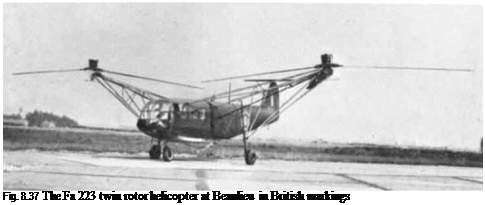Handling Qualities Degradation through Flight System Failures
The second issue of the Journal of the Helicopter Society of Great Britain, published in 1947, featured just two papers. The first was by Sikorsky and has already been referred to in the Introduction to this chapter (Ref. 8.1). The second was by O. L.L. Fitzwilliams, or ‘Fitz’ as he was affectionately known to his colleagues at Westland Helicopters, where he worked at the time of writing the paper in late 1947. Fitz had previously worked at the Airborne Forces Experimental Establishment at Beaulieu, near Southampton, England, during the Second World War and his paper partly covered his experiences there, including tests conducted on German rotorcraft acquired during the closing stages of the war. One such type was the first production helicopter (Ref. 8.37) – the Focke-Achgelis Fa 223, a development of the first practical helicopter, the FW.61. The Fa 223 aircraft was flown ‘by its German crew, via Paris, to the A. F.E. E., at Beaulieu, where it arrived in September 1945, having performed the first crossing of the English Channel by a helicopter’. The Fa 223 was a twin rotor configuration with longitudinal cyclic control for pitch and differential collective for roll. Differential longitudinal cyclic gave yaw control in hover, supplemented by the rudder in forward flight. All these functions are nowadays to be found on a modern tilt rotor aircraft. More details of the flight control system on the Fa 223 are reported in Refs 8.38 and 8.39. Figure 8.37, from Ref. 8.39, shows a photograph of the aircraft at Beaulieu.
The handling qualities problems of the Fa 223 largely stemmed from the mechanism for lift control – essentially throttle and rotorspeed, which resulted in major deficiencies. To quote from Ref. 8.39,
In hovering or in low speed flight, the control of the lift by means of the throttle is extremely sluggish and has contributed to the destruction of at least one aircraft following a downwind turn after take off. Moreover, the sluggishness of the lift control necessitates a high approach for landing and a protracted landing manoeuvre, during which the aircraft is exposed to the dangers consequent on operation of the change mechanism.

The ‘change mechanism’ allowed the pilot, via a two-position lever, to change the mean blade pitch to its helicopter position (up) or its autorotation position (down). Lowering the lever caused the engine clutch to be disengaged, and the rotor blades rotate at a controlled rate (via a hydraulic ram and spring) to the autorotative pitch setting. This mechanism operated automatically in the event of engine failure, transmission failure and a number of other ‘failure modes’, some of which appear not to have been fully taken into account during design (Ref. 8.39). The failure mechanism was also irreversible and Fitz recounts his experience during an early flight test with the aircraft, when an auxiliary drive failure caused an automatic change to the autorotative condition (Ref. 8.37).
Once the mechanism had operated, even voluntarily, it was impossible to regain the helicopter condition in flight and a glide landing was necessary. In fact, with the high disc loading of this aircraft (author’s note; 5.9 lb/ft2 at 9,500 lb) and the absence of any control over the blade pitch, a glide landing was essential and if there was not enough height for this purpose the operation of this so-called safety mechanism would dump the aircraft as a heap of wreckage on to the ground. This actually happened, at about 60-70 ft above the ground, shortly after the machine arrived at Beaulieu, and I was among those who were sitting in it at the time. In consequence, I have a strong prejudice against trick gadgets in helicopter control systems and also a rooted objection to helicopters, however light their disc loadings, which do not allow the pilot direct manual control over the blade pitch in order to cushion a forced landing.
Although the Fa 223 first flew in August 1940, at the cessation of hostilities only three aircraft existed and the loss of the aircraft at Beaulieu brought to a premature end to the testing of what was undoubtedly a remarkable aircraft with a number of ingenious design features, notwithstanding Fitz’s prejudices.
Nowadays, the safety assessment of this design through a failure modes and effects analysis (FMEA) would have deemed the consequences of this failure mode close to the ground ‘catastrophic’, and a greater reliability would be required in the basic design. An engine failure at low altitude would have been equally catastrophic of course, without control of collective pitch, as Fitz implied, but this is no justification
for having a safety device that itself had a hazardous failure mode. In handling qualities terms, the failure, at least while the aircraft was in hover close to the ground, resulted in degradation to Level 4 conditions, the pilot effectively losing control of the aircraft. In the Introductory Tour to this book in Chapter 2, the author cited another example of a helicopter being flown in severely degraded handling qualities. The cases of the S.51 and the Fa 223 are highlighted not to demonstrate poor design features of early types (hindsight offers some clarity but usually fails to show the complete picture), but rather to draw to the reader’s attention to the way in which the helicopter brought new experiences to the world of aviation, 40 years after the Wright brothers’ first flight, at a time when ‘flying qualities’ was in its infancy and still a very immature discipline. But a holistic discipline it would become, spurred by the need for pilots and engineers to define a framework within which the performance increases pursued by operators, for commercial or military advantage, could be accommodated with safety. How to deal with failures has always been an important part of this framework and we continue this chapter with a discussion of current practices for quantifying flying qualities degradation following failures of flight system functions.











